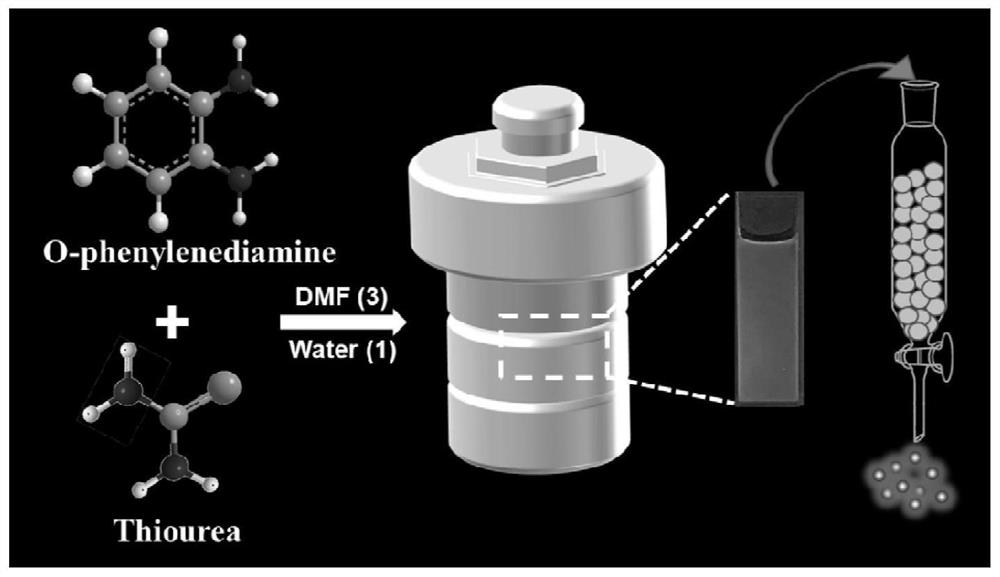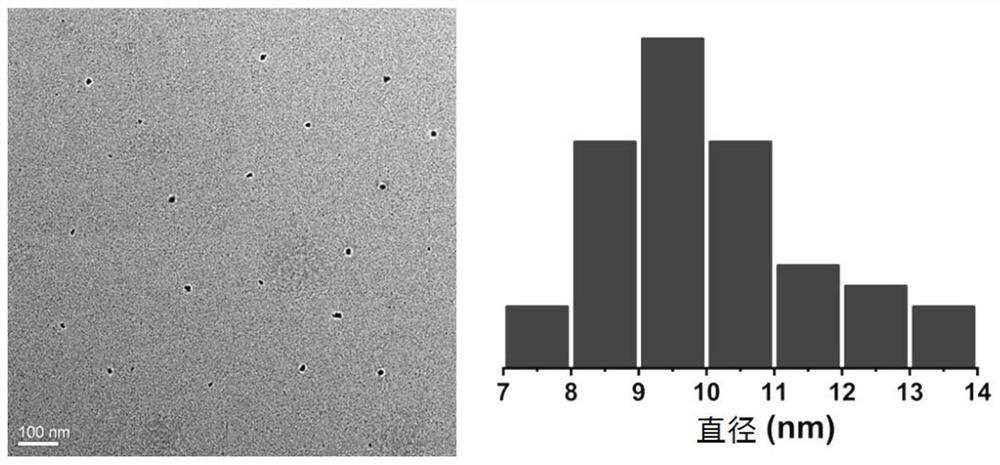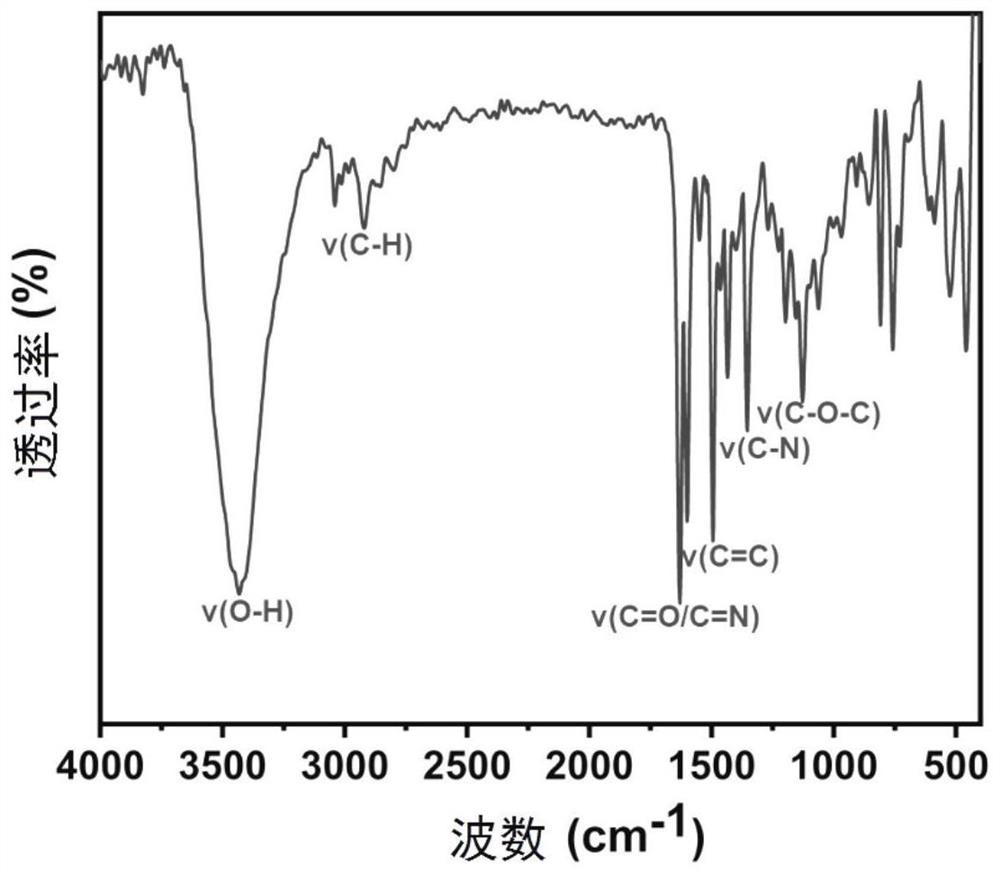Carbon quantum dot fluorescent probe for lipid droplet specific labeling as well as preparation method and application thereof
A technology of carbon quantum dots and fluorescent probes, applied in the field of fluorescent biosensing, can solve the problems of poor stability and high cost, and achieve the effects of increased fluorescence intensity, high signal-to-noise ratio, and low cytotoxicity
- Summary
- Abstract
- Description
- Claims
- Application Information
AI Technical Summary
Problems solved by technology
Method used
Image
Examples
Embodiment 1
[0046] The preparation method of the carbon quantum dot fluorescent probe provided in this embodiment, such as figure 1 shown, including the following steps:
[0047] (1) To prepare the precursor reaction solution, put 2g of o-phenylenediamine and 0.5g of thiourea into a beaker, then add 30mL of N,N-dimethylformamide (DMF) and 10mL of deionized water into it, and stir it magnetically Completely dissolve to obtain the precursor reaction solution;
[0048] (2) To prepare carbon quantum dots, place the precursor reaction solution in a 100mL reactor, and then raise the temperature to 210°C for 10 hours; after the reaction is completed, allow the reactor to cool naturally to room temperature;
[0049] (3) to obtain carbon quantum dots, the resulting reaction solution is first filtered with a 0.22 μm filter membrane to remove large particle reaction products; then, the filtered reaction solution is separated through a silica gel chromatographic column (dichloromethane and methanol ...
Embodiment 2
[0051] The preparation method of the carbon quantum dot fluorescent probe provided in this embodiment, such as figure 1 shown, including the following steps:
[0052] (1) To prepare the precursor reaction solution, put 2g of o-phenylenediamine and 0.5g of thiourea into a beaker, then add 30mL of N,N-dimethylformamide (DMF) and 10mL of deionized water into it, and stir it magnetically Completely dissolve to obtain the precursor reaction solution;
[0053] (2) To prepare carbon quantum dots, place the precursor reaction solution in a 100mL reactor, then raise the temperature to 170°C and react for 12 hours; after the reaction is completed, allow the reactor to cool down to room temperature naturally;
[0054] (3) to obtain carbon quantum dots, the resulting reaction solution is first filtered with a 0.22 μm filter membrane to remove large particle reaction products; then, the filtered reaction solution is separated through a silica gel chromatographic column (dichloromethane an...
Embodiment 3
[0056] The preparation method of the carbon quantum dot fluorescent probe provided in this embodiment, such as figure 1 shown, including the following steps:
[0057] (1) To prepare the precursor reaction solution, put 2g of o-phenylenediamine and 0.5g of thiourea into a beaker, then add 30mL of N,N-dimethylformamide (DMF) and 10mL of deionized water into it, and stir it magnetically Completely dissolve to obtain the precursor reaction solution;
[0058] (2) To prepare carbon quantum dots, place the precursor reaction solution in a 100mL reactor, and then raise the temperature to 240°C for 8 hours; after the reaction is completed, allow the reactor to cool down to room temperature naturally;
[0059] (3) to obtain carbon quantum dots, the resulting reaction solution is first filtered with a 0.22 μm filter membrane to remove large particle reaction products; then, the filtered reaction solution is separated through a silica gel chromatographic column (dichloromethane and metha...
PUM
| Property | Measurement | Unit |
|---|---|---|
| pore size | aaaaa | aaaaa |
| particle size | aaaaa | aaaaa |
Abstract
Description
Claims
Application Information
 Login to View More
Login to View More - R&D
- Intellectual Property
- Life Sciences
- Materials
- Tech Scout
- Unparalleled Data Quality
- Higher Quality Content
- 60% Fewer Hallucinations
Browse by: Latest US Patents, China's latest patents, Technical Efficacy Thesaurus, Application Domain, Technology Topic, Popular Technical Reports.
© 2025 PatSnap. All rights reserved.Legal|Privacy policy|Modern Slavery Act Transparency Statement|Sitemap|About US| Contact US: help@patsnap.com



